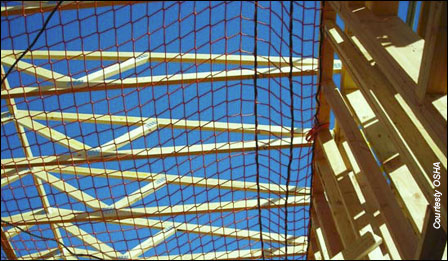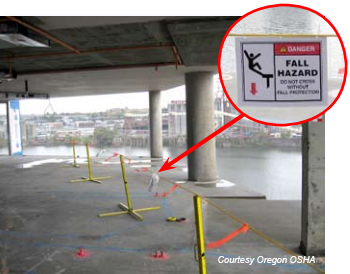Fall Protection: Fall Protection Systems
Last Updated: October 6, 2020 3:09:45 PM PDT
Give feedback
Learn about personal fall protection systems.

Fall protection systems (FPS) are intended to prevent employees from falling off, onto or through working levels and to protect employees from falling objects.
A personal fall protection system (PFPS) is one option of protection OSHA requires for workers on construction sites who are exposed to vertical drops of 6 feet or more.
Fall protection hierarchy:
- Guard Rail System
- Fall Restraint
- Fall Arrest
Requirements
Any employee or contractor is required to wear a personal fall protection system and follow FPS guidelines:
- Use a body harness at all times; body belts are not an acceptable part of a personal fall protection system.
- Use shock-absorbing lanyards or self-retractable lifelines (SRL's) to keep impact forces on the body to a minimum.
- Use nylon rope or nylon straps with locking snap hooks for restraints.
- Lanyards must have self-locking snap hooks.
- Inspect all personal fall protection equipment before each use.
- Any components that are deteriorated, bent, damaged, impacted, and/ or show excessive wear, must immediately be removed from service.
- The maximum free fall distance is not to exceed 6 feet.
- The following factors can affect total fall distance:
- Deployment of shock absorber (max. 42 inches)
- Initial position of worker before free fall occurs (e.g, sitting, standing)
- Length of connecting means (i.e. lanyard length, use of carabiners, snap hooks)
- Movement in the lifeline
- Position and height of anchorage relative to the work platform/ area (when possible, keep anchor points above the head)
- Position of D-ring slide on the body harness
Calculating total fall distance
Total fall distance (TFD) is defined as:
- The sum of Freefall Distance (FFD), Deceleration Distance (DD), Harness Effects (HEFF), Vertical Elongation (VEL) and Safety Factor (SF).
- To calculate total fall distance use the following equation: TFD = FFD+DD+HEFF+VEL+SF
- Include a safety factor of 2 feet.
- Allow the minimum calculated clearances necessary above the ground, equipment, or other obstruction at the end of the fall from the fall arrest point.
Fall protection systems
Guardrails
- Top rails must be at 42 inches ± 3 inches high and withstand 200 pounds of force in any outward or inward direction. When conditions warrant, the height of the top edge may exceed 45 inches. Guardrails made only from steel, wood, and/ or wire rope is acceptable. If wire rope is used for top rails, it must be flagged at no more than 6 feet intervals with high visibility material. Guardrail systems must comply with the current Cal/ OSHA standards. Based on job location or requirements, guardrails may be placed in or around the following areas:
- Elevated openings
- Open excavations or pits
- Leading edges of roofs or mezzanines
- Mid rails must be installed halfway between the top edge of the guardrail (top rail) system and the walking/ working surface when there is no wall or parapet at least 21 inches high. The mid rails must be capable of withstanding, at any point, without failure, a force of at least 150 pounds applied in any downward or outward direction.
- Toe boards must be a minimum of 3 ½ inches in vertical height from their top edge to the level of the walking/ working surface, and no more than ¼ inch clearance above said surface. They must be solid or have openings not over 1 inch in greatest dimension. Toe boards must be capable of withstanding, at any point, without failure, a force of at least 50 pounds applied in any downward or outward direction.
PFPS: Engineered lifelines
Lifeline systems must be designed and approved by an engineer or qualified person, see glossary of terms (PDF), have appropriate anchorages, strength of line designed to hold the number of individuals connected to it, line strength to aid in the arrest of a fall, and durability to hold a fallen employee suspended until a rescue can occur.

- Verify on suspended scaffolds or similar work platforms with horizontal lifelines that may become vertical lifelines, the devices used to connect to a horizontal lifeline are capable of locking in both directions.
- Verify horizontal lifelines are designed, installed, and used under the supervision of a qualified person as part of a complete personal fall arrest system that maintains a safety factor of at least 2.
- Verify anchor points, lanyards and vertical lifelines have a minimum breaking strength of 5,000 pounds per employee.
- Verify when vertical lifelines are used, each employee is attached to a separate lifeline.
- During the construction or inspection of elevator shafts, two employees may be attached to the same lifeline in the hoistway, provided that all of the following conditions are met:
- Both employees are working atop a false car that is equipped with guard rails.
- The strength of the lifeline is 10,000 pounds (5,000 pounds per employee).
- All other criteria specified in this paragraph for lifelines have been met.

- Verify lifelines are protected against being cut or abraded.
- Verify self-retracting lifelines and lanyards that automatically limit free fall distance to 2 feet or less are capable of sustaining a minimum tensile load of 3,000 pounds applied to the device with the lifeline or lanyard in the fully extended position.
- Verify self-retracting lifelines and lanyards which do not limit free fall distance to 2 feet or less, rip stitch lanyards, and tearing and deforming lanyards are capable of sustaining a minimum tensile load of 5,000 pounds applied to the device with the lifeline or lanyard in the fully extended position.
- Verify ropes and straps (webbing) used in lanyards, lifelines, and strength components of body harnesses are made from synthetic fibers.
PFPS: Positioning device system
Positioning device is a body harness system rigged to allow an employee to be supported on an elevated vertical surface, such as a wall, and work with both hands-free while leaning. The following is required for positioning device use:
- Rigged so an employee cannot free fall more than 2 feet.
- Secured to an anchorage capable of supporting at least twice the potential impact load of an employee's fall or 3,000 pounds. Whichever is greater.
- Connectors must be drop forged, pressed or formed steel, or made of equivalent materials.
- Connectors must have a corrosion-resistant finish. All surfaces and edges must be smooth to prevent damage to interfacing parts of the system.
- Connecting assemblies must have a minimum tensile strength of 5,000 pounds.
- D-rings, snap hooks and carabiners must be proof- tested at a minimum tensile load of 3,600 pounds without cracking, breaking, or taking permanent deformation.
Locking type snap hooks must be sized to be compatible with the member to whom they are connected to prevent unintentional disengagement of the snap hook. Unless the snap hook is a locking type and designed for the following connections, snap hooks shall not be engaged:
- Directly to webbing, rope or wire rope
- To each other
- To a D-ring with a snap hook or other connector already attached
- To a horizontal lifeline
- To any object that is incompatibly shaped or dimensioned in relation to the snap hook
- This prevents unintentional disengagement that may occur by the connected object being able to depress the snap-hook keeper and release itself
- Positioning device systems must be inspected prior to each use for wear, damage, and other deterioration. Defective components must be removed from service.
- Body harnesses and components must be used only for employee protection (as part of a personal fall arrest system or positioning device system) and not hoist materials.
- Body belts are prohibited for use at UC San Diego.
For additional information regarding Positioning Device Systems requirements, see CCR Title 8 1670 and Article 24.
PFPS: Safety nets

Safety nets must be installed as close as possible under the walking/ working surface on which employees are working, but no more than 30 feet below such level. When nets are used on bridges, the potential fall area from the walking/ working surface to the net must be unobstructed.
For additional Safety Net Information see CCR Title 8 1671 and Article 24.
PFPS: Warning line system
Roofing work on a flat roof greater than 50 feet wide (i.e., a slope < 4 in 12, vertical to horizontal) can be completed by installing a warning line and using a safety monitor. If the roof is flat and less than 50 feet wide, a competent person

safety monitor must be used. Warning lines must be:
- Erected at least 6 feet from the edge of the roof or openings
- Constructed of stationary posts made of wood, metal or comparable materials
- Have wire or nylon rope and “caution” tape strung post to post and withstand a minimum of 16 pounds of applied force
- Have a minimum breaking strength of 500 pounds and be equipped with warning line flags at intervals not to exceed 6 feet
- Guard the entire perimeter of the roof where work is being performed
- If an employee must access an area within 6 feet of the roof’s edge another employee must monitor that individual and warn him/ her of any dangers.
- Does not include employee exiting the roof via a ladder or fixed industrial ladder.
- If another employee is not available to act as a safety monitor, then the individual must don a body harness and attach a fall restraint lanyard to an anchor point to prevent reaching the edge of the roof.
Storage and maintenance
- Refrain from storing personal fall arrest equipment in the bottom of a toolbox, on the ground, or outdoors, exposed to the elements (i.e., sun, rain, snow).
- Hang equipment in a cool, dry location in a manner that retains its shape.
- Follow manufacturer recommendations for inspections.
- Clean with a mild, nonabrasive detergent and hang to dry.
- Refrain from force drying or using strong detergents when cleaning.
- Refrain from storing equipment near excessive heat, chemicals, moisture, or sunlight.
- Refrain from storing in an area with exposures to chemicals or corrosive elements.
- Avoid dirt or other types of build-up on equipment.
- Refrain from using equipment for any purpose other than personal fall arrest.
- Remove equipment from service immediately if exposed to a fall.
For more information, contact EH&S General Safety, (858) 534-7513.